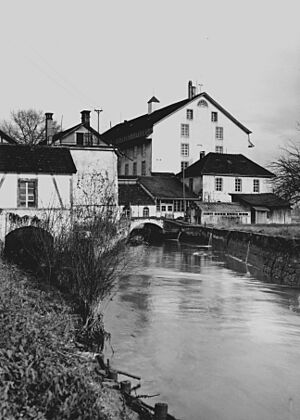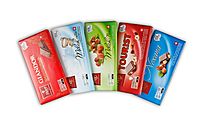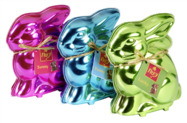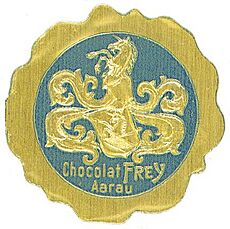Chocolat Frey facts for kids
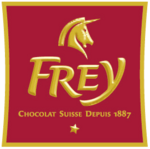 |
|
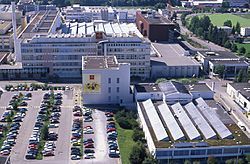
Frey Headquarters in Buchs, Aargau
|
|
| Subsidiary | |
| Industry | Food |
| Founded | 1887 |
| Headquarters | , |
|
Key people
|
Hans-Ruedi Christen (CEO) |
| Revenue | CHF 396 million (2015) |
|
Number of employees
|
1017 (2015) |
| Parent | Migros |
Chocolat Frey AG, often called Frey, is a famous Swiss company that makes chocolate and chewing gum. It's based in Buchs, Aargau in Switzerland. Frey is one of the top chocolate makers in Switzerland. Its products are sold both in Switzerland and in many other countries.
The company started in 1887 and has been part of the Migros Group since 1950. Frey is known for its own unique products and also for making similar versions of other popular chocolate bars.
Before June 2021, Frey made products mainly for Migros stores. They also supplied restaurants and other businesses. More than a third of their sales came from exports to other countries.
On June 1, 2021, Chocolat Frey joined with other Migros food companies like Delica to form a new company called Delica AG. Now, "Chocolat Frey" is a special brand under Delica AG.
History of Chocolat Frey
How Frey Started
Chocolat Frey was founded in 1887 by two brothers, Robert and Max Frey. They already knew a lot about making chocolate before they started their own family business. Robert had learned about chocolate machines in Paris, and Max had worked for a chocolate company in Zurich and even in Brazil.
On December 17, 1887, they officially started their company, "R. & M. Frey," in Aarau, Switzerland. Their first factory was in their parents' house. By 1900, they moved their main production to a larger building, an old cotton mill in the Telli area.
A special machine called the conche, invented in 1879, made it much easier to produce chocolate in factories. Robert knew about this machine and used it in their company from the start. They also used electric machines for production, which was very modern for the time. The invention of milk chocolate in 1875 also helped Frey, as it allowed them to use more local ingredients like milk and nuts, making chocolate less expensive to produce.
Early 1900s and World Wars
From 1900, Frey produced chocolate in the Telli neighborhood of Aarau. In 1906, the company became a public company. They made chocolate bars and chocolate powder. For a short time, they also made soups and tonics, but they later decided to focus only on chocolate.
During World War I, Switzerland was neutral, which helped Frey. It was easier to export chocolate, even though getting raw materials like cocoa was difficult. Because they sold well abroad, the company kept running smoothly. Their sales almost doubled between 1916 and 1918. Frey chocolate was sold in Germany, France, Sweden, and later in England.
After the war, exports dropped a lot. Germany and France were busy rebuilding, so England was their main export market. This meant Frey had to focus more on selling chocolate in Switzerland. In the early 1920s, the company almost failed. Production sometimes stopped for days. Things got better in the mid-1920s, and they tried to expand abroad again. However, the Great Depression (a big worldwide economic crisis) stopped their plans.
Robert Frey junior slowly took over the company management during these years. His father had prepared him well, ensuring the company stayed in the family. In 1932, Robert Frey senior retired, and his brother Max Frey passed away a year later.
World War II also made things tough for Frey. It was hard to trade with other countries. New rules for importing cocoa and sugar limited the Swiss chocolate market. Also, many employees and managers had to join the military service, so the company didn't have enough people. Even though demand for chocolate went up after the war, Frey couldn't make enough because of the lack of workers.
After World War II, the economy grew strongly, and Frey's situation improved. In 1946, the company started looking for partners. Four years later, in 1950, Migros took over Frey. Frey is the oldest company Migros has ever bought. Even though Frey had to follow Migros's rules, Robert Frey junior continued to manage the company. This partnership helped Frey grow a lot.
Growth and Modernization

In 1963, Frey started building its current main factory and office in Buchs, Aargau. This meant moving all their operations from Aarau. At the same time, all of Migros's chocolate and sweets production was brought together in this one location. This made Frey a modern and successful industrial company.
Since 1974, Frey has been the only Swiss company to also produce chewing gum. Today, chewing gum makes up about 10% of Frey's total sales each year.
In the 1980s, Frey's sales grew very quickly. In 1985, the company's sales went over 200 million Swiss francs for the first time. Soon after, Frey became the leader in the Swiss chocolate market. This success allowed them to invest in new improvements. They made changes to their structure and quality, and they started focusing more on environmental protection.
For example, since 1984, Frey has used district heating from a nearby trash incineration plant. This means they hardly use any heating oil. The factory also got a new Swiss Railways (SBB) train connection for easier transport. The 1980s were also important for international trade. For the first time since World War II, Frey started exporting again. Countries like the United Kingdom, the USA, Denmark, Austria, Japan, and later France and Southeast Asia, imported Frey chocolate.
During the 1990s, international trade grew even more. In 1997, Frey launched a project called 'Chocolat Frey goes international' to make exports a big part of their business.
21st Century Developments
After 2000, Frey continued to expand its international trade, especially with products made for other brands (private labels). New countries like the Netherlands, Scandinavia, Canada, and Germany started buying Frey's products. The international market became the most important way for the company to grow.
Since 2007, Frey has also sold its own brand internationally, especially in duty-free shops at airports and through partners worldwide. In 2008, Frey and Delica, another company making tasty foods, joined forces. This helped them become stronger in the international market.
By 2020, more than a third of Frey's total sales came from abroad. Their products are sold in over 50 countries on all five continents. Each year, more than 42,000 tons of chocolate, sweets, and chewing gum leave their factory in Buchs. In Switzerland, Frey is the number one chocolate maker, with about 34.9% of the market share in 2013. Chewing gum also makes up about 10% of their total sales, with most of that coming from private label products sold internationally.
In 2012, Frey celebrated its 125th anniversary.
Frey opened a new visitor center in Buchs in 2014, but it closed in August 2020. In 2014, Frey also bought SweetWorks Confections, a North American company with factories in Buffalo and Toronto.
Since the merger into Delica AG in 2021, Chocolat Frey has been a brand within that larger company. They made some changes to the brand before the merger because they faced strong competition from companies like Lindt. Frey reduced its prices, and Migros stores started selling products from Lindt and Toblerone in April 2021. Since 2015, Swiss (the airline) has been supplied with Frey chocolate.
About the Company
Frey's Headquarters
In 1966, Frey moved its main factory from Aarau to a new, specially built factory in Buchs, Aargau. Today, Buchs is still the only place where Frey makes its chocolate and chewing gum. The area has grown over time and now includes several buildings covering about 70,000 square meters. These buildings are used for storing and processing cocoa, and for making chocolate and chewing gum. The company also has its own Swiss Railways (SBB) train connection on another 10,000 square meter plot. This train connection helps them get raw materials and send out finished products.
Key Facts and Figures
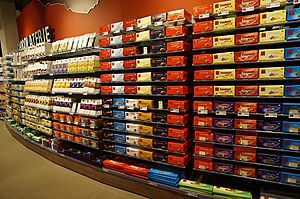
Every day, more than 500,000 chocolate bars are made at the Buchs factory. Each year, this adds up to over 41,000 tons of products, spread across 2,400 different items. Besides chocolate and pralines (small filled chocolates), Frey also makes ingredients like chocolate and cocoa powders for other food companies. They also produce chewing gum under their own brands like Skai and Candida, as well as for other companies.
With about 35% of the market share in 2015, Frey is the leading chocolate maker in Switzerland. The company employs over 1000 people. In 2015, their total sales were 396 million Swiss francs.
Quality and Safety Certificates
Frey has several important certifications that show they meet high standards for quality, safety, and environmental care:
- ISO 9001 (for quality management)
- ISO 14001 (for environmental management)
- FSSC 22000 (for food safety)
- IFS (International Food Standard)
Frey's Logo
The company logo for Frey includes a unicorn's head. This comes from the family crest of the Frey brothers, Max and Robert. Since "Frey" is also the family name, it's part of the brand name and the logo. The logo also shows "CHOCOLAT SUISSE DEPUIS 1887" (which means "SWISS CHOCOLATE SINCE 1887") on a red background. This highlights the company's long history of making traditional Swiss chocolate.
Sustainability and Helping Others
Caring for the Planet
Frey believes in "sustainable development," which means they try to balance economic success with social and environmental care. Since 2011, Frey has bought cocoa beans through the UTZ Certified program. This program helps make sure cocoa farmers get fair wages and work in good conditions.
Frey also works hard to protect the environment. They use district heating instead of crude oil, which helps reduce their energy use. They've also made other changes, trained their staff, and carefully checked their energy use. Because of these efforts, they've cut their energy use by almost a quarter in recent years, which means much less CO2 pollution. For their voluntary work to protect the climate, Frey was given the ‘CO2-reduced company’ certificate. In 2008, they also received environmental certification according to ISO 14001.
Supporting Children
Frey also helps the SOS Children's Village in Ghana. This organization supports children who have lost their parents or been abandoned. In 2007, Frey paid for one of the family houses in the SOS Children's Village Asiakwa, Ghana. Since then, they have also covered the yearly running costs for this house. The house opened in April 2008 and provides a family home for 10 children with a caregiver who acts like a mother.
See also
 In Spanish: Chocolat Frey AG para niños
In Spanish: Chocolat Frey AG para niños


